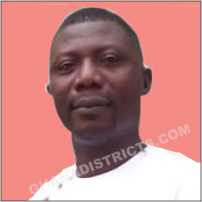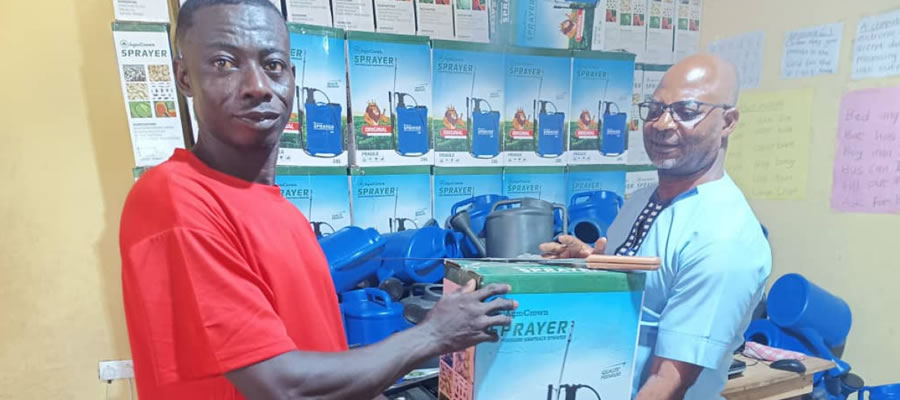

Physical and Natural Characteristics
Location and Size
The District is geographically located between latitude 50 05II and 5o 2511N and longitude 1o 5 11 and 1o 2011 W. With a short coastal strip of 5.2 km along the Gulf of Guinea and stretching inland, the District shares political and administrative boundaries with Cape Coast on the south-west, Twifo Atti Morkwa District on the north-west, Assin South District in the north, Mfantseman Municipal on the east and Gulf of Guinea in the south.
The Abura Asebu Kwamankese District Assembly has a land area of about 380 sq. km which is about 4% of the total land area of the Central Region (9562 sq. km.).The District has about 262 communities, with Abura Dunkwa as its capital.
Topography
The District is basically low-lying and undulating and elevations between 20 and 80metres above sea level. Areas around Nyanfeku Ekroful, Edumfa/Abaka and parts of Abakrampa being hilly. However, in Kwamankese Traditional Area two notable topographical features occurs in the form of Mounts Aburabura and Katakyi with elevations high enough to constitute the only critical farthest landmarks which fishermen in Moree observe on the high seas in their fishing activities in the Gulf of Guinea.
Mount Aburabura, below which is located near the village of Bosomadze, signifying the bottom of the ‘god-mount’’, is known to contain a rich biodiversity of flora and fauna and the area nearby contains traditional sacred groves with potentials for the development of tourist attraction but currently being degraded by hunters and farmers.
Figure 1: Map of the District
Climate
AAKD falls within the Evergreen and Semi deciduous forest zones. The area thus experiences double maxima rainfall. The major season starts at the end of April, peaking in May-June and declining in July. The minor rainy season begins in October and reaches a peak in November, declining by the middle of December, followed by a spell of dry, cold weather (the harmattan) in the latter part of December through the end of February. The months of August and September are relatively dry.
Annual rainfall in the southern part of the District and the coastal savanna area around Moree is generally lower between 100cm and 110cm, than in the northern interior, ranging between 110cm and 170 cm. However, the area close to the margin of the forest zone which comprises part of the Kakum valley experiences annual rainfall of about 190cm
With the closeness to the Atlantic Ocean, the District has mild temperatures ranging between 23oC and 28oC and a relative humidity of around 70 percent.
The climate has become unstable with the rains varying from year to year in terms of timing, duration and quality fundamentally attributable to large-scale deforestation and climatic change. The above has serious implications for farming
Vegetation
The vegetation consists of dense scrub tangle in the south, stretching to the Asebu and Abakrampa. Deciduous forest covers the northern or south western portion and merges with the tropical rain forest of the Kakum valley along the south eastern stretch of the district. Beyond this area and covering almost the rest of the District, the vegetation gradually becomes secondary thick bushes with isolated ‘onyaa’’ trees an uneconomic and small-sized diameter trees as a result of centuries of farming, logging and bush farming.
Figure 2: Vegetation Map of the District
Forest Reserves
The district has two forest reserves, at Kakum and Birim valleys in Abakrampa and Asebu traditional areas. These reserves serve as protective cover to some of the major rivers that drain the district.
The Kakum Forest Reserve has been developed into a tourist site that generates foreign exchange and income for the local economy and the nation as a whole. However, the district assembly does not derive any revenue directly from the operations of this tourist site. The reserve and vegetation are indicative that the District is endowed with potentially rich forest resources especially timber
Soils
The soils within the District have not been studied in terms of type and their suitability for specific crop production and other uses. Due to continuous cultivation of crops at shorter intervals as a result of population increases and traditional shifting system of farming practices, there are hardly any soils in their fertile natural state and most of the soils are generally declining in natural fertility and resulting in reduced crop yields. The soil is suitable for tree such as citrus, oil palm, cocoa and coconut. The major food crops that thrive in this area include cassava, maize, plantain, yam, and some vegetables.
Geology
The District consist of upper and lower Brimian rocks consisting of granite formation of good quality for the manufacture of products and materials for road and industrial construction. It stretches from Cape Coast through Abuenu-Abakrampa area and up to the Kwodoegya area, near the Assin border.
Near Bosomin area in the Kwamankese Traditional area is underlain by the Cape Coast granite an estimated 2.5 million-ton deposit of kaolinite for emulsion and oil paint production.
The small coastal stretch is made up of cretaceous Eocene marine sand with thin pebbly sand and some limestone; and in many parts of the district occurs in varying sizes deposits of plaster and rocks for building construction.
Although several metals, such as gold, talc and diamonds are believed to exist, appropriate studies are required to confirm their economic and industrial potential for exploration.
Figure 3: Geological Composition of the District
Drainage
The District is basically drained by three water bodies, the Kakum River, the Kura River and the Mankensu Spring. There are also several streams and swamps, which join other streams and flow into rivers especially in the rainy seasons.
The Kakum River, the most important, originates from Assin North District and flows roughly along the northern and north-western borders of the District, turns southward, flowing past Asuansi and Abenu where it was dammed in 1927 and Birimso became the centre-piece for the treatment and distribution of reasonably stable, potable water for Elmina-Cape Coast-Saltpond areas as well as for settlement along the Cape Coast-Fosu trunk motor highway, including the District headquarters. From the Birimso waterworks, the Kakum River continues towards Cape Coast drowning itself into the lagoon close by.
The Kura whose source is Wurakeseim in the northern part of the District meanders through what is described as the AburaDunkwa Lands and crosses the Fosu –Cape Coast trunk road at Kwadoegya and then flows past Korado town, entering Mfantseman District where it is dammed at KwesiAnsa town and plunges its waters into the Asafo lagoon near Hinanyi town on the sea coast.
The Mankensu, a corruption of ‘’Ndankansu’’, meaning ‘pure potable water from bead’’, is an extraordinary natural spring of noted good quality water located inAburaDunkwa. It ceaselessly exudes its waters over the surrounding area to produce swamps which slowly flow southwards across the AburaDunkwa – Cape Coast highway to join the Nsanyaako stream which in turn flows to join the river Brutu near Enyinabrim and then through Mfantseman District to empty its waters into the Atlantic Ocean near Akatakyiwa town.
Conditions of the Built-up Environment
The built Environment is made up of the man-made features and activities which support human life.
Educational infrastructure, water and sanitation facilities, health facilities, post and telecommunications and roads are some of the prominent elements that exist in this environment. Housing needs, economic as well as industrial activities are all organized within the built environment.
Basically, there are 262 settlements which are organized in a way that reflects the three most popular settlement patterns namely; linear, nucleated and scattered.
With the exception of two unique small settlements of New Ebu and New Odonase where layout was specially organized decades ago by Nana Out IX, Omanhene of the Abura Traditional Area, no other settlement in the District, has made use of any properly designated settlement layout resulting in haphazard development of structures, no orderly planned streets giving no thoroughfare for movement.
The absence of organized streets in the settlements to foster the development of any form of drainage systems has resulted in poor drainage in most of these settlements and over the years gullies have been created and erosion has taken a heavy toll on houses and undermined the foundations and, therefore, the structure of houses in most settlements. The worst form of the drainage problem is demonstrated in Moree where a storm water drainage system was started to relieve the situation but has still not been completed.
The prevalence of poor drainage has also resulted in the creation of insanitary conditions. Stagnant water, in low-lying areas of settlements, providing ideal breeding grounds for the growth and multiplication of mosquitoes.
Waste management which happened to be a problem in the most densely populated settlements like Moree, Abura Dunkwa, Abakrampa and Asebu is being addressed with the support The District Environmental Health Unit of the Assembly and waste management experts; Zoomlion Company Ltd.
Another characteristic of our built-up environment is the poor road network system in most of the hinterlands. This hinders the smooth movement of vehicles and people in the district. Problems such as potholes, erosion and creation of gullies as a result of lack of drains at the sides of the roads are some of the direct results of poor maintenance culture and neglect in some cases. These conditions make it very difficult to use the roads especially during the rainy season which also affects the transportation of food and other farm produce to the marketing centers. This has increased the incidence of post-harvest losses with its attendant loss of income to farmers and traders.
Date Created : 8/12/2024 12:00:00 AM











 facebook
facebook
 twitter
twitter
 Youtube
Youtube
 +233 593 831 280
+233 593 831 280 0800 430 430
0800 430 430 GPS: GE-231-4383
GPS: GE-231-4383 info@ghanadistricts.com
info@ghanadistricts.com Box GP1044, Accra, Ghana
Box GP1044, Accra, Ghana